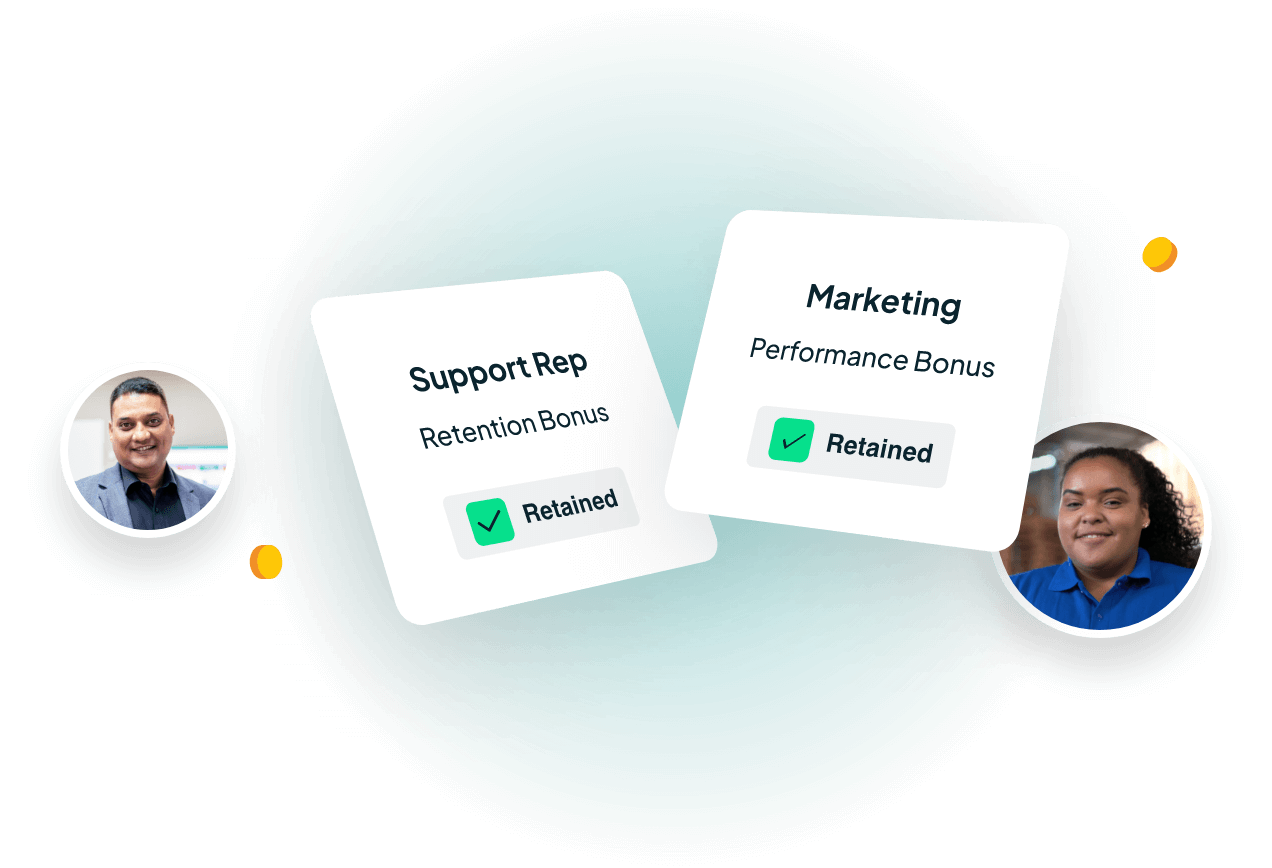-
Why Keep?
Why Keep
-
Employers
-
Employees
-
- Solutions
- Resources
- About Us
Table of Contents
- The Ultimate Guide to Employee Engagement (2023)
- Define Employee Engagement - explanation of what it is, why it is important, and how to measure it
- What is Employee Engagement?
- What is Employee Retention vs Employee Engagement?
- Why is Employee Engagement Important?
- Understand Your Employees - Learn About Their Personalities, Interests, and Backgrounds
- Motivate Your Employees - Find Ways to Keep Them Engaged With Their Work and Motivated Through Rewards and Recognition
- Create an Environment that Encourages Collaboration - Encourage Employees to Brainstorm New Ideas and Work Together Towards a Common Goal
- Foster Connections Between Employees - Create Opportunities for Colleagues to Socialize, Develop Relationships, and Share Knowledge
- Measure & Analyze Progress - track progress towards engagement goals and identify areas for improvement
- Employee Engagement Strategies
- Is There a Secret to Employee Engagement?
- What are the 5 main drivers of employee engagement?
- Employee Engagement Tools & Resources
- Employee Engagement Tools
- Employee Engagement Resources
- Internal Feedback
- Employee Recognition
- Employee Retention (or Employee Bonus / Compensation)
- Employee Engagement Ideas & Examples
- Keep Your Talent Engaged - With Keep Financial
The Ultimate Guide to Employee Engagement
As the Finance leader for your organization, you recognize the importance of creating a healthy work environment that not only incentivizes employees who are productive and motivated but are overall content with their job roles. Employee engagement is essential in any workplace, as it can make the difference between success and failure for any organization.
This guide will help to provide insight into how employee engagement works, exploring various methods and strategies to harness an engaged workforce. From understanding what truly motivates staff members to implement programs to support work-life balance, this guide will equip readers with key knowledge on how best to engage and retain talented staff at all levels of their organization.
Define Employee Engagement - Explanation of What Is It, Why Is It Important, and How To Measure It
Employee engagement is a crucial element in the success of any organization, as it represents the level of enthusiasm and commitment an employee demonstrates toward their work and the company. A workplace with high employee engagement is characterized by dedicated employees who are fully absorbed in their tasks, thereby increasing the company's productivity, creativity, and overall performance.
Businesses need to prioritize employee engagement because it not only improves the work environment but also reduces staff turnover and fosters loyalty. To measure employee engagement, organizations may use various tools and techniques, such as employee satisfaction surveys, open communication forums, and feedback systems.
By continually monitoring and enhancing employee engagement, companies can ensure the long-term success and prosperity of their organization.
What is Employee Engagement?
Employee engagement refers to the degree to which employees are emotionally invested in and committed to their work, their team, and their organization. Engaged employees are motivated, enthusiastic, and focused on achieving their goals and contributing to the success of the organization.
They are also more likely to be loyal to the organization and to stay with the company for the long term. Employee engagement is often measured through surveys and assessments that evaluate factors such as job satisfaction, motivation, and commitment.
Companies may use this information to identify areas for improvement and to develop strategies for increasing employee engagement and retention.
What is Employee Retention vs Employee Engagement?
Employee retention and employee engagement are related concepts, but not exactly the same thing.
Employee retention refers to the ability of a company to keep its employees for a certain period, often measured in years. Retention is influenced by factors such as job satisfaction, compensation, career development opportunities, and work-life balance. Companies that have high retention rates are often viewed as having a stable and committed workforce.
Employee engagement, on the other hand, refers to the emotional connection and commitment that employees have to their work, their team, and their organization. Engaged employees are enthusiastic, motivated, and focused on achieving their goals and contributing to the success of the company. Companies with high levels of engagement often have a more productive and innovative workforce.
While employee engagement and retention are related, they are not the same thing. An organization may have high retention rates but low engagement, or vice versa. Ideally, companies should strive for both high engagement and high retention, as this can lead to a more satisfied, committed, and productive workforce.
Why is Employee Engagement Important?
Employee engagement is important for several reasons:
- Increased Productivity: Engaged employees are more productive and efficient in their work. They are motivated to perform at their best, and they take pride in their work.
- Improved Customer Satisfaction: Engaged employees are more likely to provide excellent customer service, which can improve customer satisfaction and loyalty.
- Higher Employee Retention: Engaged employees are more likely to stay with the company for the long term, reducing the cost and time associated with recruiting and training new employees.
- Greater Innovation: Engaged employees are more likely to generate new ideas and approaches, leading to greater innovation and creativity within the organization.
- Better Workplace Culture: Engaged employees contribute to a positive workplace culture, where teamwork, collaboration, and open communication are encouraged.
- Improved Financial Performance: Engaged employees can lead to improved financial performance for the organization, as they are more productive and efficient, and they contribute to a positive workplace culture that can attract and retain top talent.
Overall, employee engagement is important because it can have a significant impact on the success of an organization. Engaged employees are more productive, innovative, and committed, which can lead to a more successful and sustainable business.
Understand Your Employees - Learn About Their Personalities, Interests, and Backgrounds
Gaining a deeper understanding of your employees is a fundamental aspect of creating a thriving and productive work environment. By taking the time to learn about their personalities, interests, and backgrounds, you can foster a sense of camaraderie and collaboration in the workplace.
Familiarize yourself with their unique strengths, motivations, and preferences, which can ultimately refine your leadership approach and promote team effectiveness. Open communication and active listening are essential in this process, as they enable employees to feel valued and empowered within their roles.
As a result, you'll not only be influencing an enriching, supportive culture but also exemplifying the true essence of a great leader.
Motivate Your Employees - Find Ways to Keep Them Engaged With Their Work and Motivated Through Rewards and Recognition
Keeping employees motivated and engaged in their work is crucial to maintaining a productive and happy team. One effective way of achieving this is by recognizing their efforts and rewarding them for their accomplishments.
When employees know that their hard work is acknowledged and appreciated, they're likely to feel more driven to perform at their best. Offering rewards can range from a simple gesture, like a heartfelt "thank you" or a handwritten note, to something more tangible, such as bonuses, promotions, or time off.
By incorporating both public and private recognition, you foster an environment where employees feel valued and are inspired to be innovative and take on new challenges. A culture that consistently emphasizes motivation and hard work will ultimately result in higher job satisfaction and superior team performance.
Create an Environment that Encourages Collaboration - Encourage Employees to Brainstorm New Ideas and Work Together Towards a Common Goal
Creating an environment that promotes collaboration is crucial in stimulating employees to think outside the box and work together toward achieving common objectives. By fostering a culture that values teamwork, organizations can harness the potential of their collective intelligence to drive innovation, enhance problem-solving capabilities, and spark growth.
Encouraging collaboration involves creating a safe environment where employees can openly share their insights, ideas, and viewpoints without being judged or criticized. Initiating group brainstorming sessions, using creative problem-solving techniques, and setting up shared workspaces are some effective strategies to inspire employees to collaborate.
By recognizing and celebrating the collaborative efforts and achievements of employees, organizations can reinforce collaborative behavior and ensure that teamwork remains an integral part of their company culture.
Foster Connections Between Employees - Create Opportunities for Colleagues to Socialize, Develop Relationships, and Share Knowledge
Creating opportunities for colleagues to socially connect, build relationships, and share valuable knowledge and insights is an essential element in fostering a healthy and productive work environment. Open communication and genuine connections not only lead to higher job satisfaction but also encourage the development of trust, which in turn can result in enhanced collaboration and innovation.
By organizing team-building activities, informal gatherings, and platforms for knowledge sharing, employers can facilitate personal and professional growth among employees. This mutual exchange of experiences, resources, and support has the potential to significantly enhance the overall well-being and success of the entire team.
Such connections between employees may also lead to unique solutions, and ultimately, the achievement of shared goals within an organization.
Measure & Analyze Progress - Track Progress Towards Engagement Goals and Identify Areas for Improvement
Keeping track of progress toward engagement goals is essential for both businesses and individuals seeking personal or professional growth. By diligently measuring and analyzing progress, one can pinpoint areas in need of improvement effectively.
Implementing various techniques and tools, such as metrics or analytics, can streamline this process and provide a clear understanding of the trajectory toward reaching your objectives.
A thorough assessment of your progress will not only ensure that you are on the right track, but will also help sharpen your focus, fine-tune strategies, and increase motivation to surpass expectations by identifying any weak points or opportunities that may have been bypassed otherwise.
In essence, embracing the practice of tracking and analyzing progress serves to foster sustained development and success in any endeavor.
Employee Engagement Strategies
Here are some employee engagement strategies that organizations can implement:
- Provide opportunities for career development: Offer training, mentorship, and leadership development programs to help employees develop their skills and advance in their careers.
- Foster a positive work culture: Encourage open communication, teamwork, and collaboration to create a positive work environment where employees feel supported and valued.
- Offer work-life balance: Allow for flexible work arrangements, such as telecommuting, flexible schedules, and paid time off, to help employees balance their work and personal lives.
- Conduct employee surveys: Regularly survey employees to gather feedback and insights on their job satisfaction, engagement levels, and areas for improvement.
- Provide competitive compensation and benefits: Offer competitive salaries, health insurance, retirement plans, flexible bonuses and other benefits to attract and retain top talent.
- Encourage employee wellness: Offer wellness programs, such as gym memberships, nutrition counseling, and stress management workshops, to help employees maintain their physical and mental health.
- Create opportunities for social connection: Plan team-building events, happy hours, and other social activities to help employees connect with each other and build strong relationships.
- Recognize and reward employees: Provide regular recognition and rewards to employees for their hard work and achievements, such as vesting cash bonuses, promotions, or public recognition.
These strategies can help organizations improve employee engagement and create a more productive, positive, and successful workplace.
Is There a Secret to Employee Engagement?
Ultimately, there is no one magic ingredient to employee engagement, as it is influenced by many different factors. The key is to create a culture and environment that values employees, encourages growth and development, and provides opportunities for recognition and reward.
What Are The 5 Main Drivers Of Employee Engagement?
The five main drivers of employee engagement are:
- Meaningful work: Employees are more engaged when they feel their work is meaningful and contributes to a larger purpose or goal.
- Autonomy: Employees are more engaged when they have some degree of autonomy and control over their work, such as the ability to make decisions and solve problems on their own.
- Opportunities for growth and development: Employees are more engaged when they have opportunities to learn new skills and develop their careers.
- Positive relationships with coworkers and managers: Employees are more engaged when they have positive relationships with their colleagues and managers, and feel supported and valued by their team.
- Trust and transparency: Employees are more engaged when there is a culture of trust and transparency within the organization, where employees feel that their input is valued and that communication is open and honest.
By focusing on these five drivers of employee engagement, organizations can create a workplace culture that promotes engagement, productivity, and overall success.
Employee Engagement Tools & Resources
In today's fast-paced business world, keeping employees motivated and committed to their work is of utmost importance. One way to foster employee engagement is through the effective use of tools and resources to help individuals feel connected to their organization and develop their skills.
Innovative platforms, such as employee surveys, project management software, goal-setting trackers, and continuous learning courses, play a crucial role in giving employees a voice and involving them in the decision-making process.
Social tools and team collaboration platforms help create an environment of open communication, where information flows freely, and employees can work together seamlessly to achieve larger organizational goals.
By leveraging these employee engagement tools and resources, organizations can significantly improve their employee retention rates, productivity levels, and overall satisfaction, ensuring a thriving and sustainable business.
Employee Engagement Tools
Here are some employee engagement tools and resources that organizations can use:
- Employee engagement surveys: Regularly surveying employees on their engagement levels and job satisfaction can help organizations gather feedback and insights to improve engagement.
- Learning and development programs: Offering training, mentorship, and leadership development programs can help employees develop their skills and advance in their careers, leading to increased engagement.
- Recognition and rewards programs: Providing regular recognition and rewards to employees for their hard work and achievements can help to keep employees engaged and motivated.
- Communication tools: Providing communication tools, such as chat platforms, video conferencing, and project management tools, can help employees collaborate and stay connected.
- Wellness programs: Offering wellness programs, such as gym memberships, nutrition counseling, and stress management workshops, can help employees maintain their physical and mental health, leading to increased engagement.
- Employee assistance programs (EAPs): Providing EAPs, which offer counseling and other support services to employees, can help to address personal and work-related issues that can impact engagement.
- Employee feedback tools: Providing tools for employees to give feedback, such as suggestion boxes, focus groups, or anonymous feedback channels, can help organizations gather insights on areas for improvement and increase employee engagement.
By leveraging these tools and resources, organizations can create a workplace culture that promotes engagement, productivity, and overall success.
Employee Engagement Resources
Internal Feedback
Culture Amp offers organizations the ability to create and implement programs for employee engagement and performance management. Their scientifically-backed surveys provide actionable insights into key areas such as engagement, DEI, and well-being. Partnering with Culture Amp has been shown to result in increased innovation, profitability, and even customer satisfaction.
Employee Recognition
Kudos is software for employee engagement, which facilitates the creation of positive workplace cultures and prioritizes transparent communication. In addition to encouraging employee recognition from their peers, Kudos also provides valuable insights into workplace culture and employee performance.
Employee Retention (or Employee Bonus / Compensation)
Keep Financial provides organizations with the ability to offer vesting cash bonuses to employees - upfront compensation earned over time. These upfront bonuses can be used flexibly, based on the employees’ personal needs, such as the purchase of a home, debt payments, or other net worth growth activities - ultimately, helping them to achieve their financial goals. This compensation structure represents the future of employee compensation.
Employee Engagement Ideas & Examples
Empowering employees and fostering a sense of belonging at the workplace is essential in creating an engaged and motivated team. One great example is to involve employees in decision-making processes by conducting regular brainstorming sessions or group discussions on upcoming projects and initiatives. This not only allows them to share their perspectives and insights but also fosters a sense of shared ownership in the company's success.
Another effective employee engagement idea is to recognize and celebrate individual accomplishments and milestones, whether it be by hosting a small celebration, sending a heartfelt email, or publishing their achievements in company newsletters.
Developing opportunities for personal and professional growth is also an excellent strategy as it opens doors to new knowledge and skill sets for employees, while simultaneously improving overall job satisfaction.
Encouraging team collaboration and bonding through activities like team lunches, volunteer events, or even friendly sporting competitions can help create a cohesive team environment and strengthen interpersonal relationships.
Ultimately, taking a multi-faceted approach to employee engagement can significantly impact morale, productivity, and loyalty, enriching both company culture and long-term prosperity.
Keep Your Talent Engaged - With Keep Financial
All in all, employee engagement should be a top priority for every company. After all, engaged employees are generally more productive and creative which leads to greater levels of job satisfaction and higher morale.
It is essential that leaders understand their employees, motivate them effectively, create an environment conducive to collaboration and connection among colleagues, and track progress to better gauge how effective their efforts have been. To make sure that your business is on the right track when it comes to employee engagement, utilize the vast array of resources available such as those listed in this guide, and find out what works best for you.
By aligning the financial interests of employees with those of the company, Keep Financial's vesting cash bonus can create a sense of shared purpose and commitment that helps keep top talent on board.
To learn how Keep Financial can help you deliver valuable, flexible compensation that fits the needs of today’s workforce, schedule a demo today!
Get more insight.




